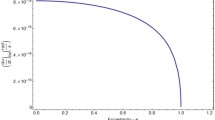Abstract
An extension of the parametrized post-Newtonian (PPN) formalism to third order in the expansion parameterm/r is used to derive analytical expressions accurate to the same order for the motion of test particles and photons in the presence of the gravitational field of the sun represented by a static, isotropic metric. The consequences of including higher-order terms are discussed in relation to the so-called classical gravitational tests for the case of general relativity theory. Present observational or experimental data are not accurate enough to detect variations due to the inclusion of higher-order terms but a planned solar probe experiment may provide information that would make such detection possible.
Similar content being viewed by others
References
Eddington, A. S. (1922).The Mathematical Theory of Relativity, Cambridge University Press, Cambridge.
Einstein, A., Infeld, L., and Hoffmann, B. (1938).Ann. Math.,39, 65.
Robertson, H. P. (1938).Ann. Math.,39, 101.
Einstein, A., and Infeld, L. (1940).Ann. Math.,41, 455.
Einstein, A., and Infeld, L. (1949).Can. J. Math.,1, 209.
Robertson, H. P. (1962). InSpace Age Astronomy, Academic Press, New York.
Schiff, L. I. (1962).J. Indust. Appl. Math.,10, 795.
Schiff, L. I. (1967). InRelativity Theory and Astrophysics 1, Relativity and Cosmology, American Mathematical Society, Providence, Rhode Island.
Will, C. M., and Nordtvedt, K. (1972).Astrophys. J.,177, 757.
Will, C. M., and Nordtvedt, K. (1972). Preprint OAP-284, Caltech, Pasadena, California.
Will, C. M. (1974). InProceedings of the International School of Physics E. Fermi, Course 56, Academic Press, New York.
Will, C. M. (1976). InProceedings of the International Symposium on Experimental Gravitation, Accademia Nazionale dei Lincei, Rome.
Birkhoff, G. (1923).Relativity and Modern Physics, p. 253, Harvard University Press, Cambridge, Massachusetts.
Deser, S., and Laurent, B. E. (1968).Am. J. Phys.,36, 789.
von Laue, M. (1920).Phys. Z.,21, 659.
Whittaker, E. T. (1928).Proc. Cambridge Philos. Soc.,24, 32.
Weinberg, S. (1972).Gravitation and Cosmology, John Wiley and Sons, New York.
Duff, M. J. (1974).Gen. Rel. Grav.,5, 441.
Braginskii, V. B., and Rudenko, V. N. (1970).Sov. Phys. Usp.,13, 165.
Landau, L. D., and Lifshitz, E. M. (1975).The Classical Theory of Fields, Pergamon Press, Oxford.
Misner, C. W., Thorne, K. S., and Wheeler, J. A. (1973).Gravitation, Freeman, San Francisco.
Fomalont, E. B., and Sramek, R. A. (1975).Astrophys. J.,199, 749.
Fomalont, E. B., and Sramek, R. A. (1976).Phys. Rev. Lett.,36, 1475.
Fomalont, E. B., and Sramek, R. A. (1977).Comments Astrophys. Space Phys.,7, 19.
Shapiro, I. I., Pettengill, G. H., Ash, M. E., Ingals, R. P., Campbell, D. B., and Dyce, R. B. (1972).Phys. Rev. Lett.,28, 1594.
Shapiro, I. I., Reasenberg, R. D., MacNeil, P. E., Goldstein, R. B., Brenkle, J. P., Cain, D. L., Komarek, T., Zygielbaum, A. I., Cuddihy, W. F., and Michael, Jr., W. H. (1977).J. Geophys. Res.,82, 4329.
Reasenberg, R. D., Shapiro, I. I., MacNeil, P. E., Goldstein, R. B., Breidenthal, J. C., Brenkle, J. P., Cain, D. L., Kaufman, T. M., Komarek, T. A., and Zygielbaum, A. I. (1979).Astrophys. J.,234, L219.
Ginzburg, V. L. (1956).Sov. Phys. JETP,3, 136.
Ginzburg, V. L. (1971).Sov. Phys. Usp.,14, 21.
Roth, E. A. (1975).Acta Astronautica,2, 543.
ESA (1976). Solar Probe. Report of the Mission Definition Study. Technical Report DP/PS (76)8.
NASA and JPL (1978). A Close-Up of the Sun, JPL Publication 78–70.
Reasenberg, R. D. (1980). InProceedings of the International School of Cosmology and Gravitation, Course 6, Plenum, Press, New York.
Hechler, M. (1976). MAD Working Paper No. 2. Information Handling Dept. ESOC.
For the frequency shift effect in a particular experimental configuration see Sarmiento G., A. F. (1982).Rev. Mex. Fis., 29–1, November.
Author information
Authors and Affiliations
Rights and permissions
About this article
Cite this article
Sarmiento, A.F. Parametrized post-post-Newtonian (PP2N) formalism for the solar system. Gen Relat Gravit 14, 793–805 (1982). https://doi.org/10.1007/BF00756090
Received:
Issue Date:
DOI: https://doi.org/10.1007/BF00756090




